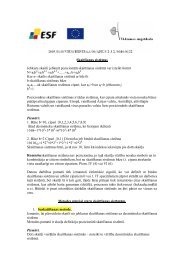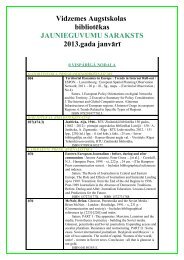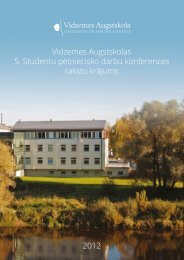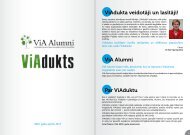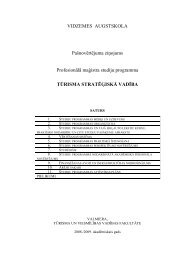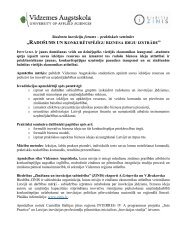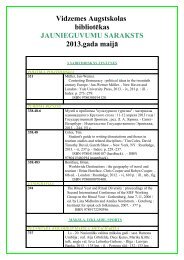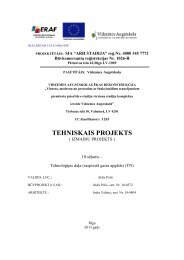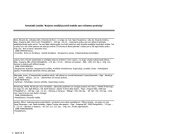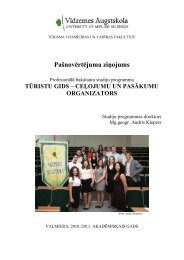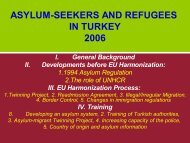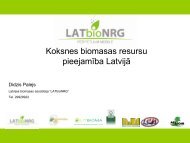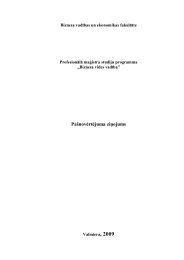Proceedings
Proceedings
Proceedings
Create successful ePaper yourself
Turn your PDF publications into a flip-book with our unique Google optimized e-Paper software.
Integration of Requirements of Nature Management Plans into Spatial<br />
Planning: Methods and GIS Tools<br />
JOLANTA BĀRA, KRISTĪNA AKSJUTA, DAINIS LAZDĀNS, MĀRIS NITCIS 1<br />
Introduction<br />
Latvia has about 15 years experience of the development<br />
of nature management plans for Specially Protected<br />
Nature Territories (SPNTs). This process is currently<br />
regulated by several legal acts (laws and regulations<br />
of the Cabinet of Ministers). Nevertheless, it is still<br />
challenging to achieve integration of the requirements<br />
of nature management plans (NMPs) into spatial<br />
planning (SP).<br />
The article provides an analysis of the tools and<br />
methods for integration of nature conservation issues<br />
into spatial planning. This includes using GIS tools,<br />
Strategic Environmental Impact Assessment (SEIA) and<br />
other methods.<br />
Applying GIS tools in nature management plans<br />
and during their implementation helps to assess<br />
environmental impact and pressures of several activities<br />
to vulnerable habitats and species, as well as serves as an<br />
easily accessible source of information. It is necessary<br />
to accumulate data of various characteristics and from<br />
a range of sources for the creation of management plans<br />
for Specially Protected Nature Territories. This includes<br />
geographic, geological, biological, and ecological<br />
data as well as economic and legal analysis referring<br />
to SPNTs, structural zoning, encountered specially<br />
protected species and biotopes, land cadastre, forms<br />
of cadastre-registered property and land owners, etc.<br />
This vast expanse of information is best organized<br />
when thematically structured with electronic data bases<br />
accompanying each constituent component, which will<br />
facilitate its further use in the GIS setting for sampling,<br />
splitting or merging, and thematic restructuring of<br />
information (e.g. areas exposed to erosion or biologically<br />
valuable areas) (Lazdāns, Nitcis, 2008).<br />
Most of the habitats in SPNTs are vulnerable to<br />
recreational pressure and commercial activities. These<br />
habitats are not mapped and evaluated in all SPNTs.<br />
Therefore, the activities of lake owners, renters, water<br />
users, landowners and municipalities threaten these<br />
habitats. For example, houses, car parking places<br />
and camping sites can be accidentally built into the<br />
areas of endangered habitats. GIS mapping with the<br />
information identified above would allow managers to<br />
select less valuable habitats for building, thus leaving the<br />
endangered habitats untouched.<br />
All SPNTs contain habitats and species of EU and<br />
international importance, but they are not inventoried or<br />
mapped fully. Only the most important and immediate<br />
threats to such habitats are identified. There are no<br />
detailed habitat maps in municipalities. Due to incomplete<br />
information, further management and building activities<br />
can threaten the habitats.<br />
The GIS-based methods are one of the possibilities to<br />
achieve incorporation of nature conservation measures<br />
into spatial planning documents.<br />
Examples: 3-D modeling and erosion risk assessment<br />
(Lazdāns, Nitcis, 2008); 3-D modeling and planning of<br />
tourism infrastructure and build-up areas, and digital<br />
databases and interactive maps of nature values.<br />
Nevertheless, there are still gaps and limitations.<br />
The main gaps in transferring information from nature<br />
management plans to spatial plans can be linked to the<br />
low awareness of nature conservation among spatial<br />
planning specialists, as well as the limited knowledge<br />
among developers of nature management plans for<br />
SPNTs (Bāra, 2007).<br />
Other limitations are differences in procedures and<br />
contents of both planning documents (Table). Most<br />
influencing factors are the different aims of these<br />
planning documents (nature conservation in case of<br />
NMPs, and the regional development in case of SPs),<br />
and different procedures and structures of both planning<br />
documents, which can confuse and make suspicious<br />
spatial planners, municipality staff members and local<br />
people alike. The difference in administrative borders<br />
of SPNTs and municipalities/regions can be rated<br />
dually – both an advantage and challenge, because there<br />
is the opportunity to gather together more people from<br />
different municipalities and get more information and<br />
opinions, as well as the risk of more unsurfaced ambitions<br />
and personal/historical disagreements among people<br />
1<br />
Daugavpils University, Vienības iela 13, Daugavpils, LV-5400 Latvia, e-mail: jolanta.bara@biology.lv,<br />
kristina.aksjuta@biology.lv, dainis.lazdans@du.lv, maris.nitcis@biology.lv<br />
15



